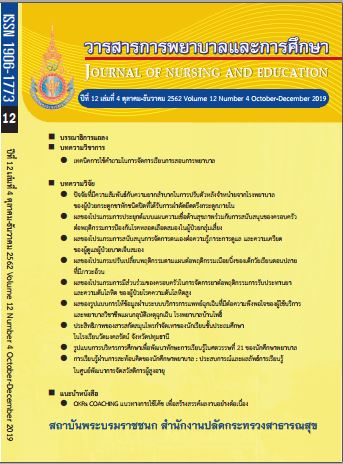ผลของโปรแกรมการประยุกต์แบบแผนความเชื่อด้านสุขภาพร่วมกับ การสนับสนุน ของครอบครัวต่อพฤติกรรมการป้องกันโรคหลอดเลือดสมองในผู้ป่วยกลุ่มเสี่ยง
The Effects of Application of the Health Belief Model with Family Support Program on Preventive Behaviors Against Cerebrovascular Disease among Individual at Risk
คำสำคัญ:
แบบแผนความเชื่อด้านสุขภาพ, การสนับสนุนของครอบครัว, พฤติกรรมการป้องกันโรคหลอดเลือดสมองบทคัดย่อ
บทคัดย่อ
ความเชื่อด้านสุขภาพและการสนับสนุนของครอบครัวมีความสำคัญต่อการพัฒนาพฤติกรรมการป้องกันโรคหลอดเลือดสมองในผู้ป่วยกลุ่มเสี่ยง การวิจัยกึ่งทดลองแบบสองกลุ่มวัดก่อนและหลังการทดลองนี้มีวัตถุประสงค์เพื่อศึกษาผลของโปรแกรมการประยุกต์แบบความเชื่อด้านสุขภาพร่วมกับการสนับสนุนของครอบครัวต่อพฤติกรรมการป้องกันโรคหลอดเลือดสมองในผู้ป่วยกลุ่มเสี่ยง กลุ่มตัวอย่างเป็นผู้ป่วยโรคเบาหวานและโรคความดันโลหิตสูงที่ขึ้นทะเบียนเป็นผู้ป่วยกลุ่มเสี่ยงโรคหลอดเลือดสมองระดับปานกลางขึ้นไปจำนวน 60 คน(กลุ่มทดลอง 30 คน)และ กลุ่มเปรียบเทียบ 30 คน) ที่ได้มาจากการสุ่มอย่างง่าย เครื่องมือที่ใช้ในการทดลองคือ โปรแกรมการประยุกต์แบบแผนความเชื่อด้านสุขภาพร่วมกับการมีส่วนร่วมของครอบครัว และคู่มือการป้องกันโรคหลอดเลือดสมอง เครื่องมือที่ใช้ในการเก็บรวบรวมข้อมูลคือ แบบสอบถามพฤติกรรมการป้องกันโรคหลอดเลือดสมองที่มีค่าความตรงของเนื้อหา เท่ากับ 1 และค่าสัมประสิทธิ์แอลฟาของครอนบาค เท่ากับ .89 การวิเคราะห์ข้อมูลโดยใช้สถิติเชิงพรรณนาและการทดสอบค่าที
ผลการศึกษาพบว่า ภายหลังการทดลองกลุ่มทดลองมีค่าเฉลี่ยของผลต่างคะแนนพฤติกรรมการป้องกันโรคหลอดเลือดสมองมากกว่ากลุ่มเปรียบเทียบอย่างมีนัยสำคัญทางสถิติ (t = 28.73, p < .001) และพบว่า พฤติกรรมการรับประทานอาหารและการออกกำลังกายของกลุ่มทดลองมีค่าเฉลี่ยของผลต่างคะแนนมากกว่ากลุ่มเปรียบเทียบอย่างมีนัยสำคัญทางสถิติ ( t = 22.23, p < .001, t = 21.41, p < .001) ตามลำดับ
ข้อเสนอแนะจากการวิจัยครั้งนี้คือ พยาบาลและบุคลากรทางสุขภาพที่ปฏิบัติงานในโรงพยาบาลส่งเสริมสุขภาพตำบล โรงพยาบาลชุมชน หรือหน่วยงานที่เกี่ยวข้องสามารถใช้โปรแกรมการประยุกต์แบบความเชื่อด้านสุขภาพร่วมกับการสนับสนนุนของครอบครัวเป็นแนวทางการให้บริการเพื่อส่งเสริมปรับเปลี่ยนพฤติกรรมการป้องกันโรคหลอดเลือดสมองในกลุ่มเสี่ยงโดยเฉพาะผู้ป่วยโรคความดันโลหิตสูงและเบาหวาน
References
1. WHO. Stroke, Cerebrovascular Accident Retrieved [Online]. 2015 [cited 2016/11/3]. Available from: http://www.who.Int/topics/cerebrovascular accident/en/
2. Bureau of Non Communicable Disease Control, Department of Disease Control, Ministry of Public Health. Report of UN General Assembly High-Level Meeting on Prevention and Control of Non Communicable Diseases. Nonthaburi: Owit Publishing, 2014. (in Thai)
3. Institute for Research and Evaluation Medical Technology, Department of Medical Services, Ministry of Public Health. Review Literature Current Situation and Model Services of Non Communicable Diseases. Nonthaburi: Art Qualified Publishing, 2013. (in Thai)
4. Office of Policy and Planning Public Health, Ministry of Public Health. Public Health statistics 2013-2017. [Online]. 2014 [cited 2016/02/12]. Available from: http://bps.ops.moph.go.th. (in Thai)
5. Suksai, W. Application of Health Belief Model and Social Support in Health Education Program to Stroke Prevention in Hypertension Patients at Phanomphrai District, Roi-Et Province. Research and Development Health System Journal. 2013; 6(2): 45-57. (in Thai)
6. Tijayoung, S. The Factors Influencing Preventive Behaviors Amongst Risk Group Stroke Patients. Thesis Master Degree of Nursing Science, Community Nurse Practitioner. Faculty of Nursing. Bangkok : Christian University; 2014. (in Thai)
7. Nualnetr, N.& Srikha, D. Knowledge on the Stroke and Behaviors to Reduce the Risk of Stroke among risk Persons in Samliam Community, Muang District, khon Kaen Province. Journal of Medical Technology and Therapy, 2013; 24(3): 318-330. (in Thai)
8. Kumpangkaew, K. Relationships Between Perceived Risk, Perceived Warning Signs and Self- Care Behavior in Older Adults at Risk of Cerebrovascular Disease. Nursing Journal of the Ministry of Public Health. 2015; 25(2): 40-56. (in Thai)
9. Chiangthong, K. Relationships Between the Health Belief Model, Warning Signs Perception and Management of Stroke Doi Sket District, Chiang Mai. Thesis of Master Degree of Public Health, Faculty of Public Health. Chiang Mai: Chiang Mai University; 2011. (in Thai)
10. Watcharanurak, P. Factors Influencing Preventive Behavior among Stroke- Risk Patients in Songkhla Province. The Southern College Network Journal of Nursing and Public Health. 2017; 4(1): 217-233. (in Thai)
11. Ross, A.(2013). The Impact of Physical Activity on Mortality in Patients with High Blood Pressure: a Systematic Review. J. Hypertense. 2012; 30(7): 1277-88.
12.Rosenstock, M.l., Strecher, V.J., & Becker, M.H. Social learning Theory and Earth Belief Model. Health Education Quarterly, 1988; 15(2): 75-138.
13. Bureau of Non Communicable Disease Control, Department of Disease Control, Ministry of Public Health. Guidelines for Assessment of Cardiovascular Risk. Bangkok; Commercial Printing House; 2015. (in Thai)
14. Chonburi Provincial Public Health Office, Ministry of Public Health. Report of Non
Communicable Disease Situation Chonburi Province Data 2557-2559. Chonburi:
Computer Center Department of Health Strategic Development; 2016. (in Thai)
15.Polic DF, Beck CT. Nursing Research: Generating and Assessing Evidence for Nursing Practice. Lippincott Williams & Wilkins; 2012.






